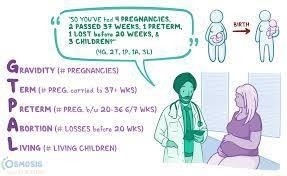A nurse in a prenatal clinic is reviewing the health record of a client who is at 28 weeks of gestation. The history includes one pregnancy, terminated by elective abortion at 9 weeks; the birth of twins at 36 weeks; and a spontaneous abortion at 15 weeks. According to the GTPAL system, which of thea following describes the client's current status?
40122
20020
40122
30202
None
None
The Correct Answer is C
The correct answer is: c. 42022
Choice A: 40122
Reason: This choice is incorrect because it indicates 4 pregnancies (correct), 0 term births (correct), 1 preterm birth (correct), 2 abortions (correct), but 2 living children (incorrect). The client has 2 living children, which is correct, but the term and preterm counts are not accurate.
Choice B: 20020
Reason: This choice is incorrect because it indicates 2 pregnancies (incorrect), 0 term births (correct), 0 preterm births (incorrect), 2 abortions (correct), and 0 living children (incorrect). The client has had 4 pregnancies, 1 preterm birth, and 2 living children.
Choice C: 42022
Reason: This choice is correct. It indicates 4 pregnancies (current pregnancy, elective abortion, twins, spontaneous abortion), 0 term births, 2 preterm births (twins at 36 weeks), 2 abortions (elective at 9 weeks, spontaneous at 15 weeks), and 2 living children (twins).
Choice D:
The GTPAL system is used to assess a client's obstetric history:
- G (Gravida): The total number of pregnancies, including the current one.
- T (Term births): The number of pregnancies carried to at least 37 weeks.
- P (Preterm births): The number of pregnancies delivered between 20 and 36 weeks, 6 days.
- A (Abortions): The number of pregnancies ending before 20 weeks (spontaneous or elective).
- L (Living children): The number of children currently alive.
For this client:
G (Gravida): 4 (one elective abortion, one twin pregnancy, one spontaneous abortion, and the current pregnancy).
- T (Term births): 0 (the twin pregnancy was delivered at 36 weeks, which is preterm).
- P (Preterm births): 1 (twins delivered at 36 weeks count as one preterm birth).
- A (Abortions): 2 (one elective abortion at 9 weeks, one spontaneous abortion at 15 weeks).
- L (Living children): 2 (the twins).
Thus, the GTPAL for this client is 4-0-1-2-2.

Nursing Test Bank
Naxlex Comprehensive Predictor Exams
Related Questions
Correct Answer is B
Explanation
A) "Maybe next time you can have a vaginal delivery.": This response may not be appropriate as it assumes a future pregnancy and vaginal delivery is guaranteed. It may not address the client's current feelings of disappointment adequately.
B) "It sounds like you are feeling sad that things didn't go as planned.": This is the correct answer as it shows empathy and validates the client's feelings of disappointment. It acknowledges the client's emotions and provides support during this sensitive time.
C) "You can resume sexual relations sooner than if you had delivered vaginally.": While this statement may be true, it is not directly related to the client's expressed feelings of disappointment.
D) "At least you know you have a healthy baby.": This response dismisses the client's feelings and may not be wellreceived, as the client is expressing a desire for emotional support rather
than a reassurance about the baby's health.
Correct Answer is C
Explanation
Choice A: Posterior neck flexion is not an expected change during pregnancy.
Choice B: Increased abdominal muscle tone is not an expected change during pregnancy. In fact, the abdominal muscles tend to stretch and may become less toned as the uterus expands.
Choice C: During pregnancy, the woman's center of gravity shifts due to the growing uterus, leading to an increased arch in the lower back known as lordosis. This change helps to maintain balance and reduce the strain on the back. The other options are not expected physiologic changes during pregnancy.
Choice D: Decreased mobility of pelvic joints is not an expected change during pregnancy. Some joint laxity may occur due to hormonal changes, but decreased mobility is not typical.
Whether you are a student looking to ace your exams or a practicing nurse seeking to enhance your expertise , our nursing education contents will empower you with the confidence and competence to make a difference in the lives of patients and become a respected leader in the healthcare field.
Visit Naxlex, invest in your future and unlock endless possibilities with our unparalleled nursing education contents today
Report Wrong Answer on the Current Question
Do you disagree with the answer? If yes, what is your expected answer? Explain.
Kindly be descriptive with the issue you are facing.
